High-tech wearables for stroke rehab use sensors like accelerometers, gyroscopes, and EMG to monitor movement, muscle activity, and joint angles in real time. They provide instant feedback to help you track your progress and allow clinicians to personalize your therapy. These devices support remote monitoring and tele-rehabilitation, making recovery more accessible. If you’re curious about the latest innovations and how these tools can enhance your recovery journey, there’s more to explore ahead.
Key Takeaways
- Wearable devices like accelerometers and gyroscopes monitor limb movement, joint angles, and muscle activity in real time.
- Inertial measurement units (IMUs) combine sensors for comprehensive tracking of movement patterns during recovery.
- AI-powered wearables analyze data to personalize therapy plans and detect subtle improvements in motor function.
- Continuous remote monitoring enables clinicians to assess progress and adjust treatments without in-person visits.
- Smart textiles and embedded sensors provide unobtrusive, real-time feedback on movement quality and recovery metrics.
Types of Wearable Devices Used in Stroke Rehabilitation
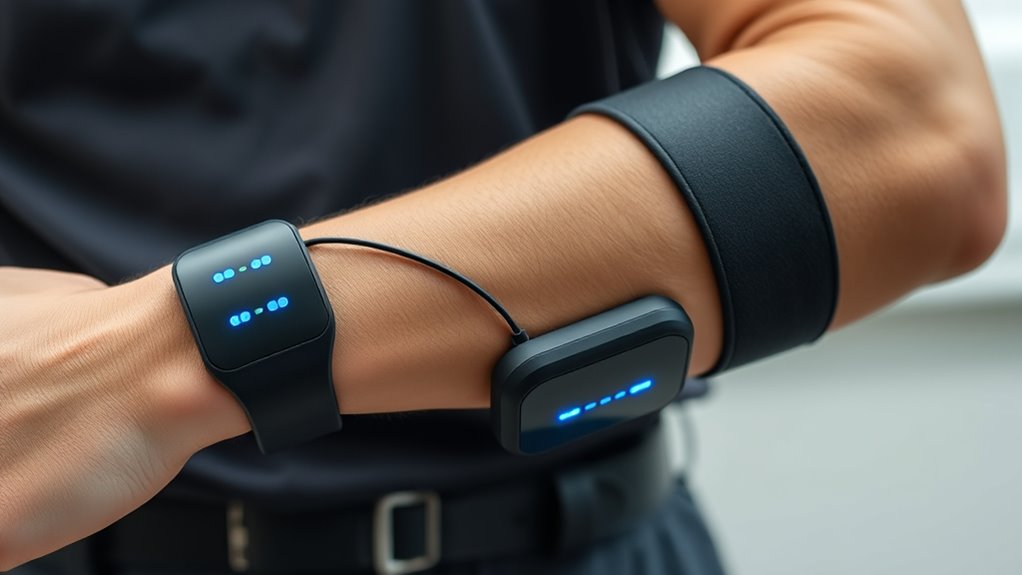
Wearable devices have become essential tools in stroke rehabilitation, offering real-time feedback and continuous monitoring. You might use accelerometers, which track movement patterns and intensity, helping to assess your progress. Gyroscopes provide detailed data on joint angles and limb orientation, giving insights into your range of motion. Inertial measurement units (IMUs) combine these sensors, delivering comprehensive movement analysis. Additionally, smart textiles and wearable gloves incorporate sensors directly into clothing or accessories, making monitoring less intrusive. Some devices are designed specifically for upper or lower limbs, ensuring targeted support. These wearables collect vital data that helps your healthcare team tailor your therapy, monitor improvements, and motivate you throughout recovery. The variety of device types ensures personalized approaches suited to your unique needs, and understanding sensor technology can enhance your engagement with rehabilitation tools. Moreover, advancements in AI-driven data analysis are increasingly enabling more precise and adaptive therapy plans based on the data collected. Additionally, ongoing innovations are improving battery life and user comfort, making long-term use more feasible and effective.
How Wearables Monitor Motor Recovery and Movement
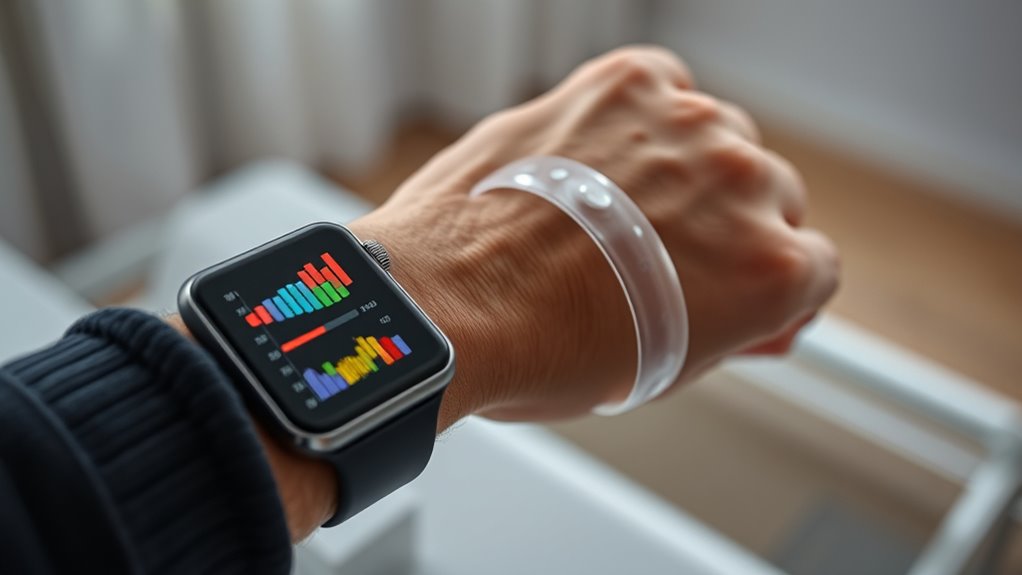
Wearables track your motor recovery by analyzing your movements in real time, giving instant feedback on your progress. They use specific metrics to measure improvements and identify areas needing focus. With this data, your rehab program becomes personalized, helping you move toward recovery more effectively. Additionally, integrating comfort solutions can enhance wearability and user compliance during extended use. Being aware of retail hours and service availability can also ensure you access these advanced devices conveniently when needed. Understanding vibrational alignment can further optimize your recovery journey by supporting a positive mindset and motivation throughout the process.
Real-Time Movement Analysis
Because they provide continuous feedback, high-tech devices can precisely track your movements in real time, offering valuable insights into motor recovery during stroke rehabilitation. These wearables use sensors to monitor joint angles, muscle activity, and limb positions, capturing detailed data with each movement. As you perform exercises, the devices analyze your motion patterns instantly, identifying improvements or areas needing more focus. This immediate feedback helps you adjust your efforts on the spot, ensuring you’re performing movements correctly. Plus, the real-time analysis detects subtle changes that might go unnoticed otherwise, giving you a clearer picture of your progress. The technology empowers you to stay engaged, motivated, and informed, making your rehab journey more targeted and effective.
Progress Tracking Metrics
Progress tracking metrics are essential tools that high-tech devices use to measure your motor recovery accurately. These metrics include data like movement speed, range of motion, and repetition counts, giving you detailed insights into your progress. Wearables collect this information through sensors that monitor your limb movements, capturing subtle improvements over time. By analyzing these metrics, your rehab team can identify patterns and pinpoint areas needing extra focus. This data also helps motivate you, showing tangible evidence of your progress. Because these metrics are objective and continuous, they offer a clear picture of how well you’re recovering. Ultimately, they enable more precise adjustments to your therapy, ensuring your rehab stays on track and optimized for your specific needs.
Personalized Rehab Plans
Since each stroke recovery journey is unique, personalized rehab plans are essential for effective therapy. Wearables collect detailed data on your motor recovery and movement patterns, giving your healthcare team real-time insights. This information allows therapists to tailor exercises that target your specific needs, focusing on improved strength, coordination, and flexibility. As you wear these devices, they track progress daily, helping identify areas where you’re excelling or struggling. Your rehab plan adapts dynamically based on this data, ensuring you’re always working on the right tasks. This personalized approach keeps you motivated and engaged, making recovery more efficient. Ultimately, wearable technology helps create a customized pathway that accelerates your progress and maximizes your chances of regaining independence.
Tracking Muscle Strength and Function With Advanced Sensors
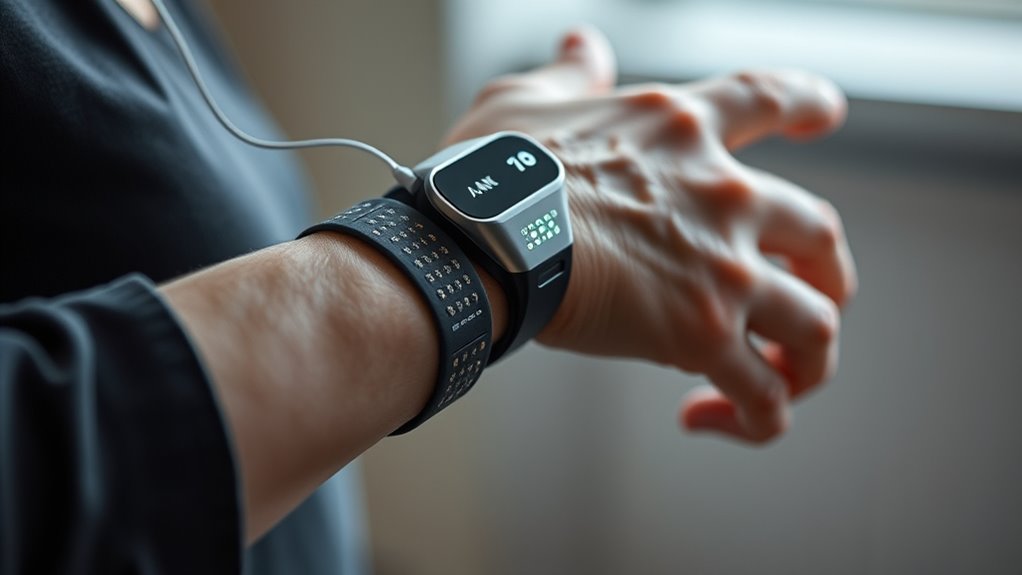
Advanced sensors have revolutionized the way stroke survivors monitor their muscle strength and function. These devices use precise, miniaturized technology to measure muscle activity, force, and movement patterns in real time. When you wear these sensors, they track how well your muscles are responding during exercises and daily tasks. You’ll get detailed data on muscle strength, coordination, and endurance, helping you understand your progress more clearly. This instant feedback allows you and your healthcare team to adjust your rehab plan quickly, targeting specific weaknesses. The sensors are non-invasive and comfortable, making it easier to stay consistent with your recovery. Additionally, sensor calibration ensures that the data collected remains accurate over time, further enhancing the effectiveness of your rehabilitation. Regular calibration and data accuracy are essential for reliable progress tracking. Incorporating smart technology can also improve your motivation and engagement throughout the recovery process. Utilizing consistent monitoring helps maintain a clear picture of your recovery trajectory, fostering better communication with your healthcare providers. By accurately capturing your muscle performance, these advanced tools empower you to take an active role in your rehabilitation journey.
Real-Time Feedback and Data Collection for Patients and Clinicians
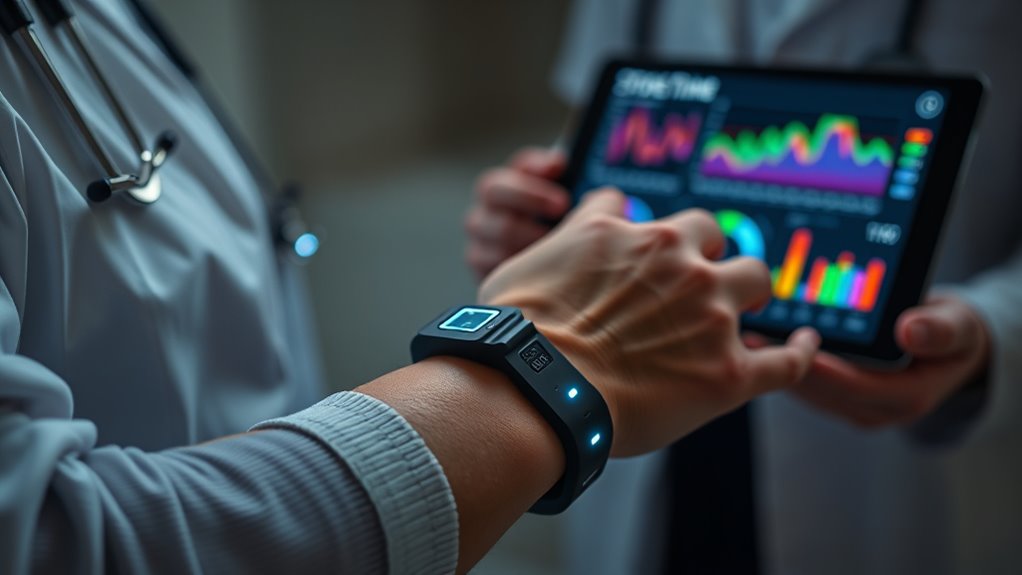
Real-time feedback from wearables lets you see your progress instantly, keeping you motivated and informed. Clinicians can continuously monitor your recovery and make personalized adjustments on the spot. Sharing data with your care team guarantees everyone stays aligned and can respond quickly to your evolving needs. Understanding divorce costs can help you plan financially for any unexpected expenses during your recovery process. Additionally, integrating Kia Tuning technologies can offer insights into vehicle performance, which can be analogous to how health wearables provide critical feedback during rehabilitation. Employing predictive modeling techniques can further enhance the accuracy of progress tracking and intervention timing. Incorporating bedroom design principles can also create a calming environment that supports healing and well-being during recovery.
Continuous Monitoring Capabilities
Continuous monitoring capabilities enable stroke patients and clinicians to receive instant feedback and collect detailed data throughout the rehabilitation process. With these wearables, you can track movement patterns, muscle activity, and progress constantly, providing an all-encompassing picture of recovery. This real-time data helps identify issues early, allowing timely interventions and adjustments. You don’t have to wait for scheduled appointments to assess progress; instead, you get constant insights that motivate and inform your recovery journey. Clinicians can remotely monitor your improvements, ensuring you stay on track and receive personalized support. These capabilities foster a proactive approach, making rehab more efficient and responsive. By capturing data around the clock, continuous monitoring transforms stroke recovery into a more precise, data-driven process.
Personalized Treatment Adjustments
Because wearable devices provide ongoing data, they enable personalized treatment adjustments that adapt to your progress instantly. This real-time feedback helps your clinicians modify therapy plans on the fly, maximizing recovery. For example, if your movements improve, the device can suggest more challenging exercises; if not, it can recommend gentler activities. This dynamic approach keeps your rehab targeted and effective. The table below illustrates how data informs adjustments:
| Data Type | Adjustment Made | Outcome |
|---|---|---|
| Movement Range | Increase exercise difficulty | Enhanced strength and flexibility |
| Fatigue Levels | Reduce session intensity | Prevents burnout |
| Reaction Time | Add cognitive tasks | Boosts coordination |
| Symptom Severity | Modify therapy focus | Addresses specific issues |
| Progress Rate | Extend or shorten rehab phases | Ensures maximum recovery |
Data Sharing With Care Teams
Wearable devices not only adapt therapy plans based on your progress but also facilitate instant sharing of your data with your care team. This real-time feedback helps clinicians monitor your recovery closely, making timely adjustments to your treatment. As you perform exercises, your device transmits data instantly, allowing your care team to see improvements or setbacks without delays. This continuous flow of information keeps everyone on the same page, ensuring personalized care tailored to your current needs. You can also receive immediate prompts or encouragement, boosting motivation. Sharing data seamlessly reduces the need for frequent clinic visits and enhances communication, making your rehab more efficient. Ultimately, this integration empowers you and your clinicians to make informed decisions that accelerate your recovery journey.
The Role of Wearables in Tele-Rehabilitation and Remote Monitoring

Wearables have become essential tools in tele-rehabilitation, enabling healthcare providers to monitor stroke recovery progress remotely with real-time data. These devices let you track movement patterns, muscle activity, and even breathing, providing valuable insights without frequent clinic visits. Here’s how they enhance remote care:
- Continuous Monitoring: Wearables record data 24/7, giving your care team a complete picture of your progress.
- Immediate Feedback: You receive instant alerts if your movements indicate setbacks or issues.
- Data-Driven Adjustments: Therapists can modify your rehab plan based on real-time information, ensuring personalized care.
- Increased Engagement: Knowing your progress is tracked motivates you to stay consistent with exercises.
These features make remote rehab more effective, convenient, and tailored to your needs.
Integrating Wearable Data Into Personalized Therapy Plans
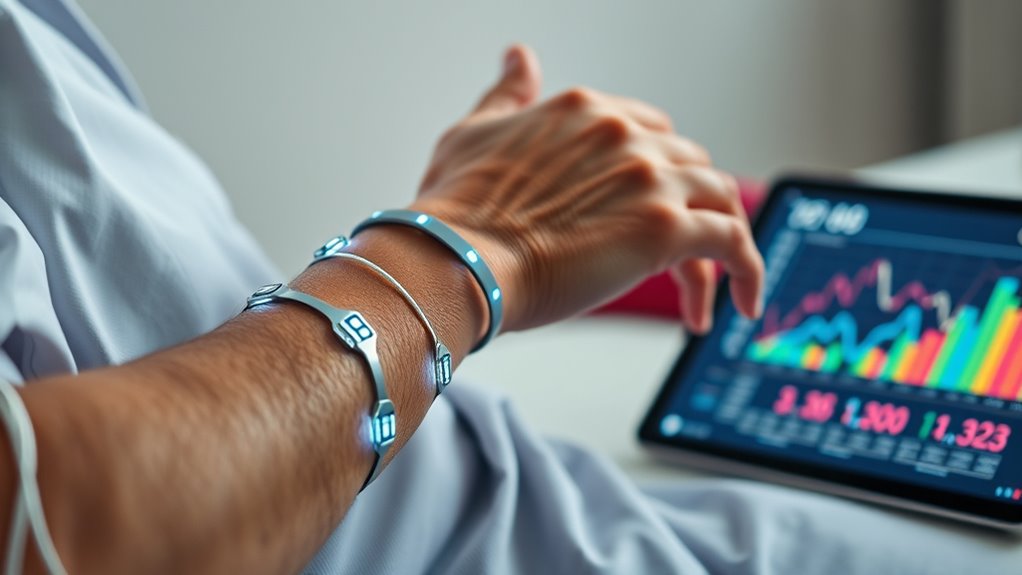
You can use wearable data to make real-time adjustments to your rehab plan, ensuring it stays effective and relevant. This personalized approach helps target your specific needs and track progress more accurately. By integrating this data, your therapy becomes more tailored and responsive to your recovery journey. Incorporating effective wall organization techniques can further optimize your home environment to support your rehabilitation process. Additionally, leveraging personal development tools such as goal setting and mindfulness practices can enhance motivation and emotional resilience during recovery. Regularly monitoring home furnishings safety features, like the proper use of heated mattress pads, can also contribute to a safe and comfortable recovery environment. Understanding website performance metrics can help therapists refine their guidance and improve overall treatment strategies, and utilizing mailing list segmentation ensures communication is personalized and effective.
Data-Driven Therapy Adjustments
By continuously collecting real-time data on your movements and performance, wearable devices enable therapists to make more informed adjustments to your treatment plans. This immediate feedback helps identify areas needing improvement and prevents overexertion. Here are four ways this data transforms therapy:
- Fine-tunes exercise intensity to match your current ability.
- Detects patterns that indicate progress or setbacks.
- Adjusts therapy frequency based on your responsiveness.
- Provides motivation by showing tangible progress.
This dynamic approach ensures your rehabilitation remains personalized and effective. Instead of sticking to a static plan, your therapy evolves based on ongoing insights from wearable data. As a result, you get a more targeted, adaptable recovery process that maximizes your gains and minimizes frustration.
Customized Rehabilitation Strategies
Integrating wearable data into personalized therapy plans allows clinicians to tailor rehabilitation strategies precisely to your evolving needs. With real-time insights into your movement patterns, they can identify specific challenges and adjust exercises accordingly. For example, if the wearable detects limited wrist movement, your therapist might introduce targeted stretching or strengthening activities. This approach guarantees your therapy remains dynamic and responsive, maximizing recovery efficiency. Wearable data also helps set realistic, measurable goals, keeping you motivated and focused. By continuously monitoring progress, your rehab plan evolves alongside your improvements, avoiding plateaus or setbacks. Ultimately, this personalized strategy increases the likelihood of regaining independence and confidence in daily activities, making your stroke recovery more effective and tailored to your unique journey.
Benefits of Continuous Monitoring Outside Clinical Settings
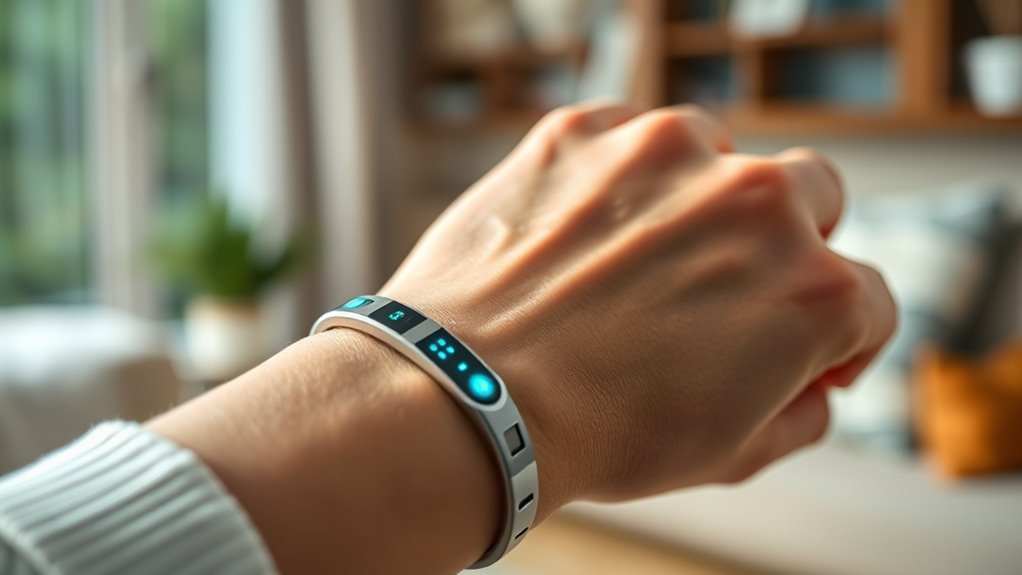
Continuous monitoring outside clinical settings offers significant advantages by providing real-time insights into your recovery progress. This allows you to stay aware of how you’re improving day-to-day, rather than waiting for scheduled visits. Here are some key benefits:
Real-time insights outside clinics help track daily recovery and enhance personalized therapy.
- Immediate Feedback: You get instant updates on your movements and exercises, helping you adjust techniques as needed.
- Enhanced Motivation: Seeing steady progress encourages you to stay committed to your rehab routine.
- Personalized Adjustments: Your healthcare team can tailor your therapy based on continuous data, making treatments more effective.
- Remote Supervision: Clinicians can monitor your recovery remotely, reducing the need for frequent clinic visits and increasing convenience.
– Regular air quality monitoring can also support your overall health during recovery by ensuring a safe environment. This ongoing insight helps optimize your rehabilitation journey, boosting recovery outcomes. Additionally, integrating smart wearables with air quality sensors can provide comprehensive data to improve your recovery environment. Moreover, leveraging ECU tuning principles used in Volkswagen modifications can optimize device performance and reliability during your recovery process. A deeper understanding of Bitcoin IRA strategies can also help you plan for long-term financial stability once your recovery is complete.
Emerging Technologies in Stroke Rehab Wearables

Emerging technologies in stroke rehab wearables are transforming recovery by offering more accurate, real-time data and advanced functionalities. You can now access devices equipped with AI-driven algorithms that analyze movement patterns, providing instant feedback to help you correct techniques. Wearables are integrating sensors like inertial measurement units (IMUs) and electromyography (EMG) to capture detailed muscle activity and joint movements. Some devices feature machine learning to personalize therapy plans based on your progress, making treatments more effective. Additionally, innovations such as haptic feedback systems and augmented reality are enhancing engagement and motivation during rehab sessions. These cutting-edge tools aim to make recovery more precise, interactive, and tailored to your unique needs, ultimately supporting faster and more efficient stroke rehabilitation outcomes. Coastal zones are also impacted by wave action and tidal movements, which can influence the effectiveness of certain wearable technologies in aquatic environments. Furthermore, the integration of machine learning enables these devices to adapt to individual recovery patterns, optimizing therapy over time.
Challenges and Limitations of Current Wearable Devices

While wearable devices have advanced stroke rehabilitation, they still face significant challenges that limit their effectiveness. First, accuracy can be inconsistent, especially with movement artifacts or varying user environments. Second, many devices lack seamless integration with other health systems, making data sharing difficult. Third, comfort and user-friendliness remain issues; some wearables are bulky or uncomfortable, discouraging regular use. Fourth, cost can be prohibitive for many patients, limiting access to the latest technology. These limitations hinder wide adoption and reliable tracking, which are essential for effective rehab progress. Overcoming these hurdles will require ongoing innovation in device design, data accuracy, affordability, and interoperability to fully realize their potential.
Future Trends in High-Tech Wearables for Stroke Recovery
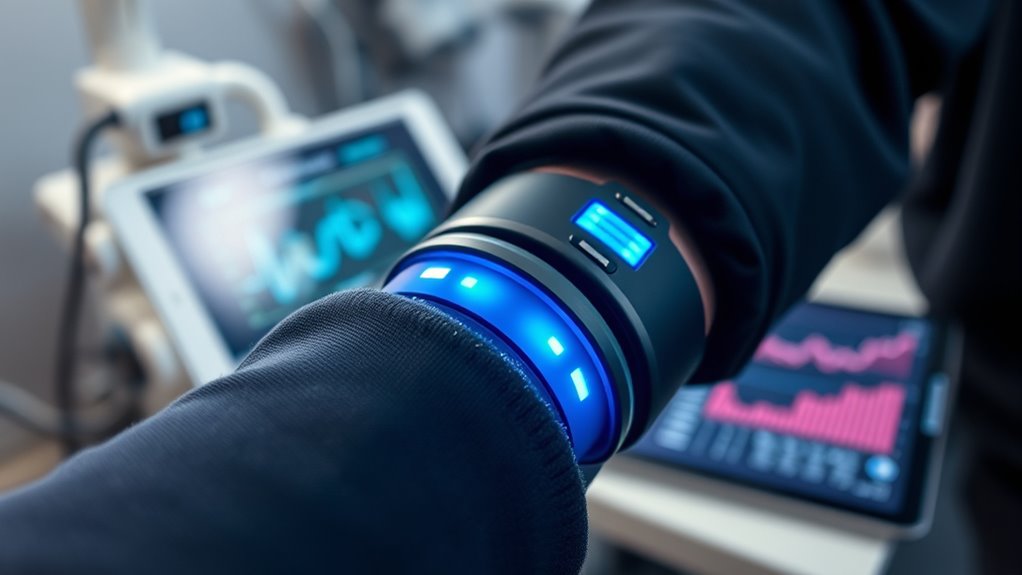
Advances in technology are paving the way for smarter, more integrated wearable devices that can revolutionize stroke recovery. Expect future wearables to incorporate AI and machine learning, providing personalized feedback and adaptive therapy plans tailored to your progress. These devices will likely feature enhanced sensors that capture more detailed data on movement, muscle activity, and even neural signals. Integration with telemedicine platforms will allow healthcare providers to monitor your recovery in real-time, offering immediate guidance and adjustments. Wearables may also become more comfortable and discreet, encouraging consistent use. Additionally, innovations like virtual reality and augmented reality could create immersive rehab experiences, making therapy more engaging. As these trends develop, you’ll have more powerful tools to regain independence and improve outcomes after a stroke.
Frequently Asked Questions
How Do Wearables Ensure Patient Data Privacy and Security?
You might wonder how wearables safeguard your data. They use encryption to protect information during transmission and storage, ensuring unauthorized access is prevented. Secure authentication methods verify your identity before accessing sensitive data. Regular software updates patch vulnerabilities, and compliance with privacy laws like HIPAA reinforces security. By following these practices, wearables help keep your health data private and secure, giving you peace of mind during your rehab journey.
Can Wearables Be Customized for Individual Stroke Rehabilitation Needs?
You can definitely customize wearables for your specific stroke rehabilitation needs. Many devices allow you to adjust settings, track particular movements, or focus on targeted exercises. By working with your healthcare provider, you can tailor the data collection and feedback features to suit your recovery goals. This personalized approach helps optimize your progress, making your rehab more effective and aligned with your unique challenges.
What Is the Cost Range of Advanced Stroke Recovery Wearables?
Imagine you’re stepping into the future, and the cost of advanced stroke recovery wearables varies widely. You might spend anywhere from $200 to over $1,500, depending on features like real-time tracking, personalized feedback, and integration with therapy programs. While some devices are affordable, others offer high-tech capabilities that come with a steeper price tag. Consider your needs and budget carefully to find the wearable that best supports your recovery journey.
How Long Do Wearable Devices Typically Last Before Needing Replacement?
You’re wondering how long wearable devices last before needing replacement. Typically, these devices have a lifespan of two to five years, depending on usage, build quality, and maintenance. Regular charging, software updates, and proper care can prolong their life. However, battery performance may decline over time, and hardware components might wear out. Keep an eye on manufacturer recommendations to ensure your device stays functional and accurate for as long as possible.
Are There Any Contraindications for Using Wearable Devices in Stroke Patients?
You should know that there are some contraindications for using wearable devices in stroke patients. If your patient has skin sensitivities, open wounds, or allergies to device materials, using wearables might cause irritation or infection. Also, avoid devices if they interfere with medical treatments or if the patient experiences seizures or severe cognitive impairments. Always consult with a healthcare professional to guarantee safe use tailored to each patient’s needs.
Conclusion
Imagine a future where your every move is tracked seamlessly, guiding your stroke recovery like a trusted companion. These high-tech wearables become your personal coach, providing real-time feedback and keeping you motivated outside the clinic. As technology advances, you’ll experience more precise, comfortable devices that fit effortlessly into your daily life. Together, you’ll open new possibilities for healing, making stroke rehab more empowering, connected, and effective than ever before.








